Zane middle school trashcan hand sanitizer
Trash bots one and two are mobile hand sanitizer dispensers designed for Zane Middle School in Eureka, California. The purpose of project is to provide two portable hand sanitizer dispensers for the students and staff of Zane Middle School, Trash bot. This project was built and designed by Team Placeholder, consisting of; Ben George, Joseph Hollingsworth, and Drake Pitchford, for the Spring 2021 ENGR215 Introduction to Design course. The motivation for this selecting this project was the opportunity to solve a problem the group found interesting and challenging.
Background[edit | edit source]
Zane Middle School is a school located in Eureka, Ca, that after being closed for several months due to COVID-19, has re-opened, with restrictions. One of the needs that has arisen from these restrictions, is the need for more hand sanitizer access points to reduce the spread of the COVID-19 virus
Zane Middle School is a middle school in Eureka, Ca, that has recently reopened, this has caused a need for more sanitation areas on campus to protect the students and staff from the spread of the COVID-19 virus. Our hand sanitizer dispensers will be located in high traffic areas such as outside of a cafeteria or at student drop of locations as school starts.
Problem statement[edit | edit source]
The objective of this project is to provide two portable hand sanitizer dispensing units for Zane Middle School. One capable of storing and cleaning P.E. equipment.
Criteria:
Upon conferring with our client representative, Trevor Hammons, Team Placeholder developed the following list of criteria to help guide the design process. Each criteria was weighted on a 1-10 scale, with a 1 being of the lowest importance, and a 10 meaning the highest importance.
| Criteria | Description | Weight (1-10) |
|---|---|---|
| Sanitation/Safety | The units must be safe to operate, and safely dispense hand sanitizer. | 10 |
| Ease of use/maintenance | The units must be easily operated and maintained by students and staff.
This will be read by people outside the US and in the future, so be sure to add enough context. Consider that most people might not even know where Arcata is. |
9 |
| Durability | ||
| Portability | Both units need to be able to be easily moved around campus by students or staff.
Should look good, sortable table for criteria |
5 |
| Versatility | Both units need to be able to operate in various locations and situations around campus.
Makes documentation informative (e.g. images, video) |
5 |
| Cost | The combined cost of both units must not exceed $325. | 4 |
| Aesthetics | The units must look appropriate for a middle school environment, and for Zane. School logos would be appreciated. | 2 |
Prototyping[edit | edit source]
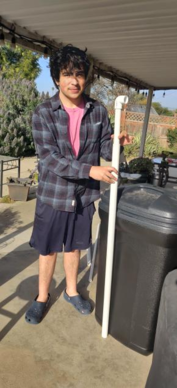
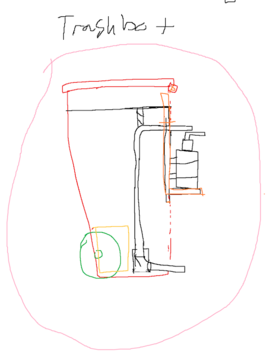
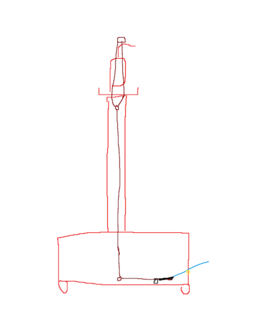


Final product[edit | edit source]
The Trash Bots are hand sanitizer dispensers comprised of wheeled garbage bins for the main body, and a mounted exterior PVC pedal mechanism, to dispense hand sanitizer. The garbage bin body is hollow, to allow for the storage of P.E. equipment, with a mounted holster for sanitizing wipes to clean off the equipment.
Trash Bot 1[edit | edit source]
Trash Bot 1 is a hand sanitizer dispenser comprised of a wheeled garbage bin for the main body, and a mounted exterior spring-powered PVC pedal mechanism, to dispense hand sanitizer out of a refillable 1-liter reservoir. The garbage bin body is hollow, to allow for the storage of P.E. equipment, with a mounted holster for sanitizing wipes to clean off the equipment.
Trash Bot 2[edit | edit source]
Trash Bot 2 is a simpler version of Trash Bot 1, made up of 3 main components: the wheeled 45 gallon trash can, the exterior mounted PVC pipe trigger mechanism and an exterior mounted Hand Sanitizer Holster.
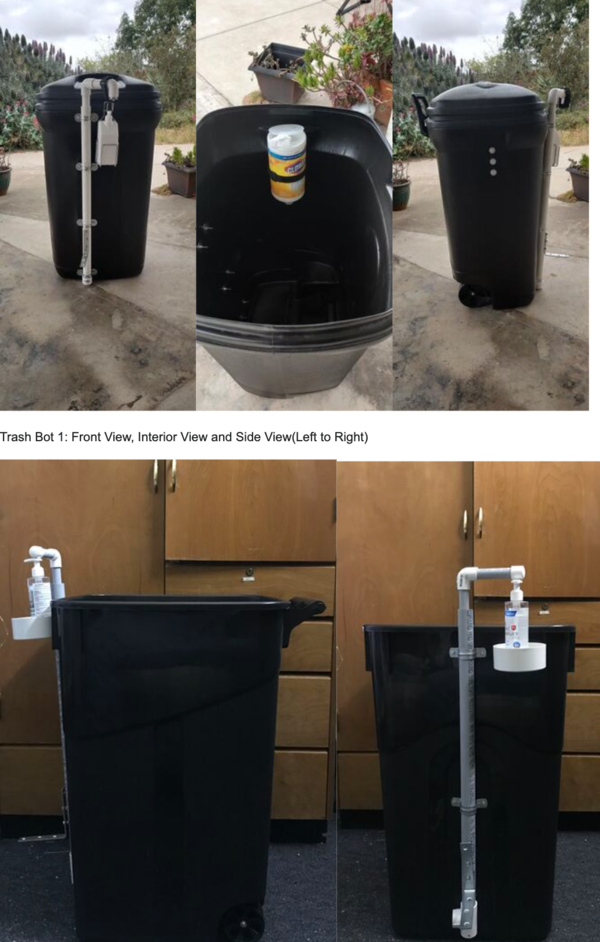
Trash Bot 2 Side View and Front View(Left to Right)
Construction[edit | edit source]
Trash Bot Construction[edit | edit source]
Both Trash Bots primarily consist of, a trigger mechanism, hand sanitizer reservoir, and a trash can.
Both trigger mechanisms consist of 2 concentric PVC tubes that freely slide inside each other, powered by a compression spring at the bottom. For the pedal of the trigger mechanism, a small slit is bored into the outer PVC pipe. An L bracket is then attached to the inner pipe via screws, with hex nuts as spacers. When pushed down, the L bracket brings down an arm placed on top of a bottle of hand sanitizer, which then dispenses said hand sanitizer. Both trigger mechanisms are attached via metal PVC pipe straps to the trash cans.
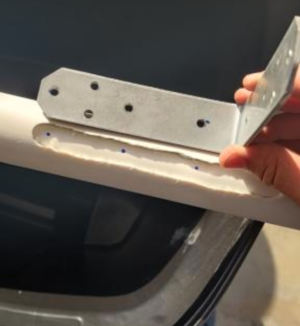
Each trash bot has a slightly different hand sanitizer reservoir. Trash bot 1 uses a refillable 1-liter container that sits in a mount screwed into the trash can. Trash bot 2 uses a screwed in tray, that holds sanitizer bottles.
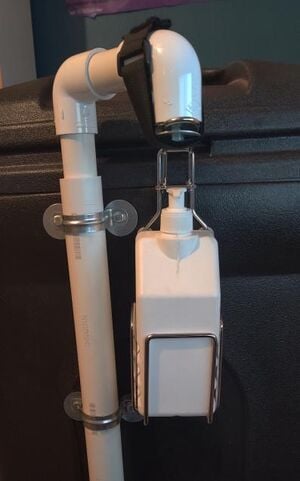
Trash Bot 1 also has a wipe container inside the unit. The wipe container consists of another L bracket bolted into the unit, with a Velcro strap retaining the wipe container.
The tools needed to construct trash bot are
- PVC cutters
- PVC concrete
- Drill
- Various sizes of twist drill bits
- Hex wrench/socket wrench set
- Screwdriver
Bill of materials[edit | edit source]
The table shown below depicts the description of costs.
| Item | Amount | Cost per unit | Total |
|---|---|---|---|
| 45 Gallon Trash Can | 2 | USD 30.00 | USD 60.00 |
| Hardware — various screws and washers | 17 | USD 2.00 | USD 34.00 |
| 1" PVC — several sections of PVC | 3 | USD 6.00 | USD 18.00 |
| PVC 1/2" — several sections of PVC | 2 | USD 9.00 | USD 18.00 |
| PVC Cement — Required for fusing PVC | 2 | USD 6.00 | USD 12.00 |
| Hand Sanitizer — To fill the design for delivery | 2 | USD 7.00 | USD 14.00 |
| Compression Spring — for the trigger of the mechanism | 2 | USD 0.00 | USD 0.00 |
| Hand sanitizer reservoir — Trash Bot 1's storage system | 1 | USD 0.00 | USD 0.00 |
| Velcro Strips — Trash bot 1's straps | 1 | USD 0.00 | USD 0.00 |
| Grand total | USD 156EUR 134.16 <br />GBP 113.88 <br />CAD 193.44 <br />MXN 3,252.60 <br />INR 11,676.60 <br /> | ||
Schedule[edit | edit source]
This is when to maintain what
- Daily
- Check hand sanitizer supply (Replace if necessary)
- Check sanitizing wet wipes (Replace if necessary)
- Monthly
- Check foot pedal bolts to tighten
- Yearly
- Test compression spring replace if needed
Instructions[edit | edit source]
This video demonstrates the process of using the Trash Bot 1 and Trash Bot 2
Conclusion[edit | edit source]
Testing results[edit | edit source]
Trash Bot 1 and Trash Bot 2 are functional systems and will serve their intended use.
Lessons learned[edit | edit source]
As a group we all collected social skills by going through the design process as a group and having a client we needed to communicate with regularly, as well as gaining skills in software such as Auto CAD and in construction skills.
As a group if we could change anything we would of discussed more with our client.
Next steps[edit | edit source]
We are considering streamlining the design process and making our design compatible with a stenciled system to allow customizations between schools.
Troubleshooting[edit | edit source]
| Problem | Suggestion |
|---|---|
| Foot Pedal Breaks | Mount new L bracket foot pedal on system |
| Compression Spring Wears Down | Replace spring by removing inner PVC tube and placing new spring inside then resealing |
| Foot Pedal Jams | Remove inner PVC tube and clean then re-assemble the trigger mechinism |
Team[edit | edit source]
- Joey Hollingsworth
- Ben George
- Drake Pitchford
